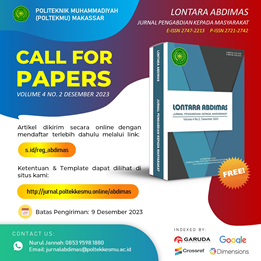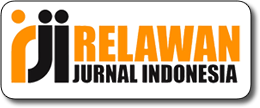Optimasi Posyandu Asoka II Dusun Pammase Desa Selli Kecamatan Bengo
Abstract
Abstract
In general, rural health services in community health centers that require time to carry out child examinations, to be affordable for the whole community for maternal and child health services, have formed integrated service posts in each hamlet, like Posyandu Asoka II Pamamse Hamlet. To improve the quality of services and health for cadres and the community, by optimizing Posyandu management. A manual recording and reporting system was developed with the computerization of the Simposyandu system. Increase the knowledge of cadres and the public about healthy food sources and systems hydroponic planting. The method of implementing community partnership program activities is by identifying problems, through discussions with cadres and providing solutions to solve Posyandu problems and implementing improvements by conducting training to use the Simposyandu, and training in viticultural or hydroponic cultivation. The results of this activity are the establishment of an IT-based Simposyandu program and quality human resources with cadres who are skilled at operating computers with information technology systems so that management and administration can be neater and more effective. Communities can meet healthy food sources from home yards by cultivating hydroponic for vegetables and biopharma, making it a modern Posyandu and a healthy and prosperous family.
Keywords— Simposyandu, Optimization, Computerized, Hygroponics
References
[2] A. Bahri, “Teknologi bercocok tanam di lahan sempit di Kecamatan Tempe Kabupaten Wajo,” hal. 605–608.
[3] A. Supriyanto dan B. Hartono, “Penerapan Sistem Informasi Posyandu Bagi Kader Di Kecamatan Semarang Selatan,” Rekayasa, vol. 15, no. 2, hal. 64–71, 2018.
[4] A. Supriyanto, “Peran teknologi informasi bagi kader posyandu dalam kegiatan pendataan KIA,” Pros. Semnasvoktek, hal. 360–365, 2017.
[5] W. Mulyani dan B. E. Purnama, “Pembangunan Sistem Informasi Data Balita Pada Posyandu Desa Ploso Kecamatan Punung Kabupaten Pacitan,” Speed - Sentra Penelit. Eng. dan Edukasi, vol. 7, no. 2, hal. 15–19, 2013.
[6] Siti Munawaroh, “Model Informasi Monitoring Kesehatan Ibu dan Bayi pada Posyandu dalam Rangka Upaya Peningkatan Kesehatan Keluarga,” Din. - J. Teknol. Inf., vol. 19, no. 1, hal. 76–85, 2014.
[7] M. Elden dan R. F. Chisholm, “Emerging Varieties of Action Research: Introduction to the Special Issue,” Hum. Relations, vol. 46, no. 2, hal. 121–142, 1993.
[8] M. Iqbal, E. Basuno, dan S. Budhi, “The Essence and Urgency of Participatory Action Research in Rural Community-Based Agricultural Resource Empowerment,” Forum Penelit. Agro Ekon. Pus. Anal. Sos. Ekon. dan Kebijak. Pertan., hal. 73–89, 2007.
[9] J. Friend, Participatory action research and social change, 2nd edition, vol. 12, no. 6. 1999.











